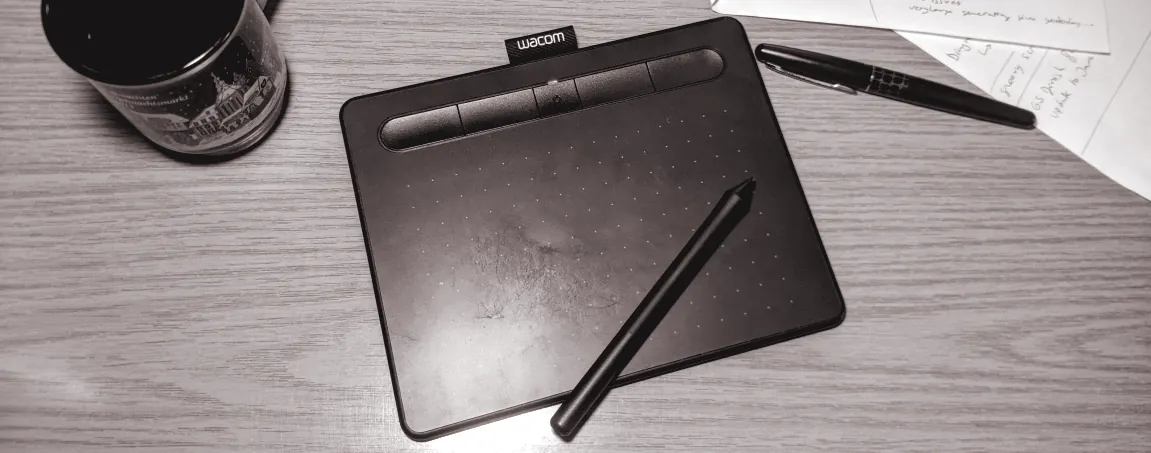Category: Linux
Map Wacom Tablet to a Single Display
How to map a graphics tablet to a single display in a multi-monitor setup in Linux

Wacom Intuos graphics tablet
I have a Wacom Intuos graphics tablet for my occasional drawing and signing. By default, the tablet area is mapped to the whole screen area, making it almost unusable if you are using two or more monitors, as your drawing application of choice (Krita in my case) usually resides in one display only. Well, turns out there’s a very easy way to map the tablet to a single display in Linux with xinput.
Run a Command When Files Change
Learn about entr and how it can help you
If you usually develop your software without an IDE, it may come in handy to be able to run a custom command or two whenever a file or a group of files in the file system is modified. This post discusses entr, a small event notify test runner which might just be what you need to fill an inconvenient gap in your mouseless development environment.
Transmission, a CLI Torrent Manager
How to use transmission from CLI and remotely

At home, I have a scrawny HTPC called chimp in my living room connected to the TV —as I don’t own a Smart TV for good reasons—. Even though I have a NAS in the network capable of serving media, I connected a dedicated external disk directly to chimp because my stock router is not the fastest around. Whenever I use the HTPC, I use it remotely from either my desktop, bonobo, or my laptop, simian. Sometimes I need to fetch torrents and download them to the disk connected to the HTPC.
Enter Transmission. Transmission is a somewhat popular BitTorrent client that includes a ‘hidden’ command line interface which is very, very useful and simple to use. Learn to use it and you will probably never want to open a GUI torrent client ever again.
A Few Words About MPD
MPD is the superior way to access your music library
I remember many years ago, when I was a Windows user, and even later after I made the switch to Linux, I always struggled to find the perfect music player that would fit my needs perfectly. From time to time I would fantasize about programming my own little, perfect, shiny music player program that would fit my needs perfectly like Cinderella’s shoe. But I was nowhere near naïve enough to actually start the project, let alone finish it. I know how much time and effort it would take. Then I discovered mpd (Music Player Daemon).
Use Smartphone as a Webcam
Droidcam makes the setup easy on Linux
These days of coronavirus where a lot of people work from home the number of teleconferences per unit of time has skyrocketed. Most of us are forced to use video conferencing software of dubious privacy practices1 without having much say in the choice, but that is a story for another day. If you are like me and do not have an external webcam to plug into your PC, don’t run off to the store just yet. There are solutions to make your Android smartphone act as a webcam that work really well. One of them is droidcam from Dev47Apps, which works even if you don’t have Google Services installed. This post quickly discusses how to set this up on your Linux PC using both wifi and ADB.
Arch With LVM on LUKS
Arch Linux installation with LVM on a LUKS-encrypted drive
Edit (2020-06-16):
use dd to create swap file instead of fallocate
Edit (2021-07-01):
fix typo in GRUB_CMDLINE: cryptodevice -> cryptdevice
Edit (2021-11-04):
fix terminology mess-up: LUKS on LVM -> LVM on LUKS
Disclaimer: some of the steps in the Arch Linux installation procedure change from time to time, so I would recommend checking out the awesome Arch Linux installation guide in the Arch wiki to get a fully up-to-date picture of the process.
It is well known that Arch Linux does not have the easiest installation process of all Linux distributions. In my opinion, for technical users this is a big plus, as you get to know your system better simply by having to set it up from scratch. This comes with the perk that you only install the packages you need, leading to a smaller and arguably snappier system.
In this guide, I’m documenting my latest Arch Linux installation on my laptop, where I set up a logical volume with LVM on top of a fully-encrypted disk with LUKS. Encrypting your disk in your mobile devices should be a requirement if you value your security and/or privacy. Nowadays it has almost no performance penalties and it provides countless benefits.